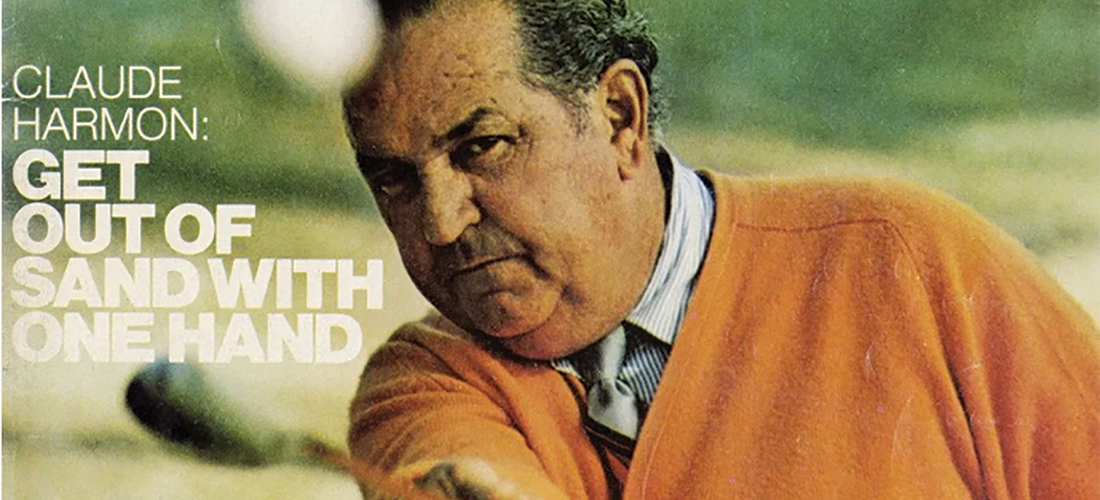
The Boss
The wit and wisdom of Claude Harmon
By Lee Pace
Every morning in the late 1970s at Winged Foot Golf Club, Lex Alexander had three jobs: Make the toast, pour the coffee, and sit down with Claude Harmon and review Harmon’s lesson schedule for the day. From there, who knows?
Alexander, the young assistant professional, was ready for anything tagging along with the 1948 Masters champion and renowned head pro at the venerable club in Mamaroneck, New York. He would certainly be entertained, educated and regaled with insights and stories from Harmon’s lively career in golf. He’d do some physical labor, e.g., teeing balls up for the older members as Harmon tried to eke out a hair more clubhead release through their impact position. To be Harmon’s right-hand man at one of America’s finest clubs was high cotton for a boy from Charlotte.
“For four years, I had the best job in golf,” Alexander says. “You hung around ‘The Boss’ and listened to him tell stories, you watched him teach, you gave your own lessons and then you played or practiced. You got to play a lot of golf. He wanted you to be a good player. He said, ‘Don’t be going out there and shooting 78.’ He said, ‘You don’t have to answer the phone and sell gloves. I can hire other people to do that.’
“He was such a character. Boy, was he funny.”
Harmon was just 33 years old and working at Winged Foot when he won the Masters, beating Cary Middlecoff by five shots. The club pro business was better suited to Harmon during that era given he would have six children (with sons Butch, Craig, Claude II and Billy following him into the golf business), and there was meager money on the pro tour. So he served more than three decades at Winged Foot with winters spent at Seminole Golf Club in Palm Beach, Florida, and later at Thunderbird Country Club in Palm Springs, California.
Alexander fell into Harmon’s sphere of orbit in 1975 at the suggestion of John Buczek, a fellow Wake Forest University golfer who had worked at Winged Foot, and Davis Love Jr., who’d taught Alexander the game at Charlotte Country Club in the 1960s and was friends with Harmon. Lex played golf at Wake Forest in the early 1970s on teams that featured Lanny Wadkins, Curtis Strange, Jim Simons and Eddie Pearce, among others. He caddied on the PGA Tour for a couple of seasons out of college, then decided to test the golf instruction waters at Love’s suggestion.
Looking back four decades later, Alexander chafes that Harmon didn’t get the recognition and respect that Alexander feels he deserved. Harmon gave lessons to presidents Kennedy, Nixon and Ford, and the Moroccan king, Hassan II. He nurtured an impressive list of young pros like Mike Souchak, Dave Marr, Rod Funseth, Dick Mayer and Jackie Burke, in addition to his own sons.
“I would submit that Claude Harmon was a golfing genius,” says Alexander, who lives in Durham and is a regular at Duke University Golf Club. “Every lesson was awe-inspiring. His eyes were blue with a definite twinkle. With each shot, his eyes would dart from the set-up to the club as it swung back, then he took a mental photograph of the clubface position at the top. He had a keen sense of sound as well and would listen intently for clues when club impacted ball. Then he would pick up the flight of the ball and watch until it fell to the ground. He always said, ‘Lex, watch the ball. The ball doesn’t lie.’”
Harmon was famous for executing and teaching bunker shots and was pictured on the cover of Golf Digest in 1972 saying, “Get Out of Sand With One Hand!”
“The Boss would do a clinic or an outing of some kind,” Alexander says. “He would say, ‘OK, here’s the deal! I’m going to explain the fundamentals of playing a bunker shot, then I’m going to hit a few, but once I make my first one, we are out of here!’
“I remember there was one night that he made the first shot, and, true to his word, he climbed out of the bunker and bid the crowd farewell.”
Harmon once had Alexander break a branch of about 4 feet in length from a nearby hedge and then swing the branch as if he were swinging a golf club. Harmon watched and turned to his pupil.
“Do you hear that noise?” Harmon asked, then gave the branch to the golfer and implored him to swing the branch and “Let me hear some noise!” Soon enough, the older fellow was cracking pure 5-iron shots.
“As we rode back to the clubhouse, the Boss said to me, ‘I hope you learned something here this morning because you just witnessed a miracle,’” Alexander says.
On more than one occasion Alexander can remember Harmon taking umbrage when a member told him he was flying to Florida and taking a lesson from Bob Toski, another prominent teacher of the era. After one such trip, Harmon queried the man about his session with Toski.
“What did Mr. Toski teach you?” Claude asked.
“He strengthened my left-hand grip,” the member answered.
Harmon didn’t flinch. “Did he teach you how to chip out of the woods?”
Harmon thumbed his nose at much of the convention in the golf instruction business. Among his pet peeves were articles and advice telling golfers to “Take it back low and slow” or “You need to slow your swing down.” He also took no truck in instructors who couldn’t play a lick themselves.
“The Boss used to say, ‘Teachers who never had any success playing, why would you listen to them? If they knew what they were talking about, they would make themselves a good player,’” Alexander says.
The rotund Harmon loved to eat and was at his best holding court at the dinner table with a cocktail and big piece of meat. Alexander laughs at a standard line when Harmon perused the menu in a new restaurant.
“Let’s get one thing straight,” he would tell the waiter. “I don’t want anything swimming or flying. Four legs on the ground for me.”
Harmon loved pork chops and eggs for breakfast and hated turkey at Thanksgiving. “If those Pilgrims had a taste of a nice rib eye, we wouldn’t have to eat this dry turkey every Thanksgiving,” Harmon said every November.
Overweight and ridden with high cholesterol, Harmon spent time in a cardiac program at a Houston clinic near where son Dickie lived and worked at River Oaks Country Club. Miserable at being starved and fed healthy food, Harmon one day paid a window washer $100 to bring him a meatball sub.
“It took him two hours to remove all the evidence,” Alexander says. “He had sauce all over his face and gown. He told the guy, ‘I don’t know where you’re washing windows tomorrow, but there is another $100 where that came from!’”
Harmon didn’t suffer fools well, and one of Alexander’s favorite stories involves a member at River Oaks who was struggling with his bunker play and came to Dick Harmon for help. Dick hit a wall in helping the guy and brought his dad in for a consultation. The Boss worked with the man for half an hour, then told him to adjust his hands on the club.
“Pro, you want me to change my grip?” the man exclaimed. “I just won a toon-a-mint in Abilene! I can’t change my grip.”
The Boss said, “Dickie, what’s the soup in the grill room today? I’m all done!”
Alexander left the golf business when Harmon exited Winged Foot in 1979, and he his wife, Ann, moved to Durham, where they opened a health food store and later sold it to a burgeoning young company out of Austin, Texas, called Whole Foods. He stayed on as a consultant for many years with the flexibility to pursue interests in classical music, art, wine, gourmet cooking and playing golf with the guys at Duke and his summer club in the mountains, Blowing Rock Country Club.
The guys in Lex Alexander’s gang have had a steady diet of Claude Harmon stories for many years. PS
Longtime PineStraw golf columnist Lee Pace remembers Lex Alexander’s rhythmic and flowing golf swing from covering the Durham Amateur in the early 1980s for the Durham Morning Herald.





